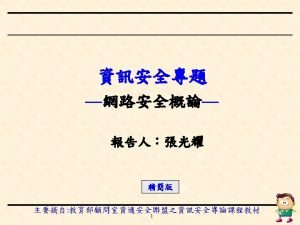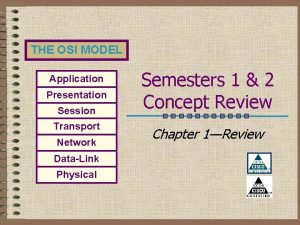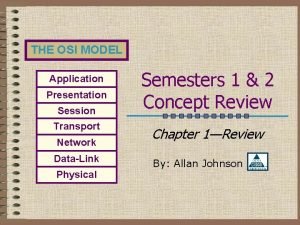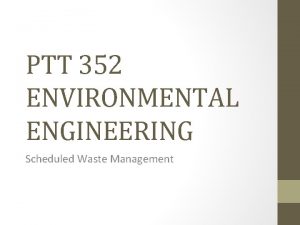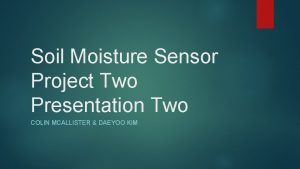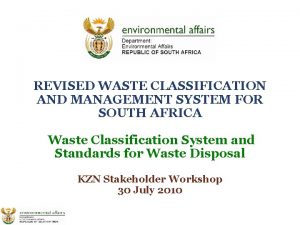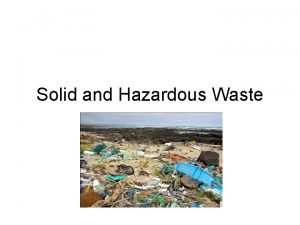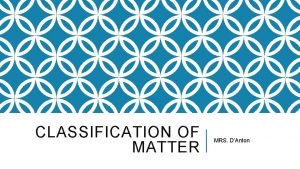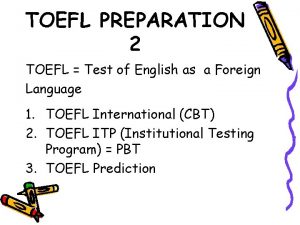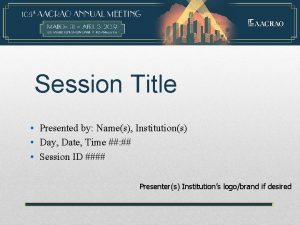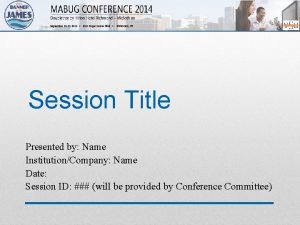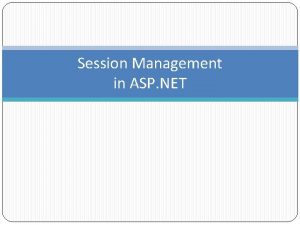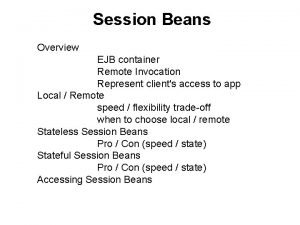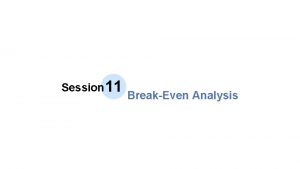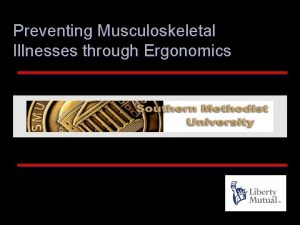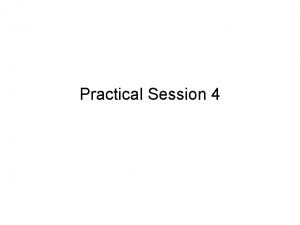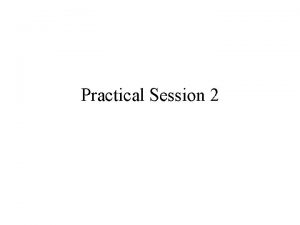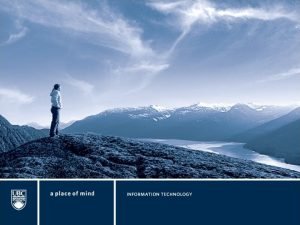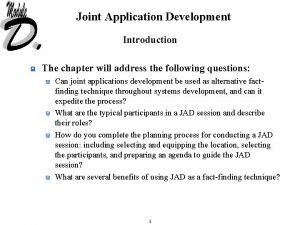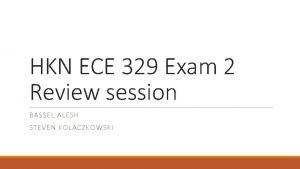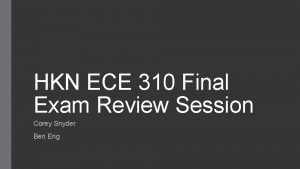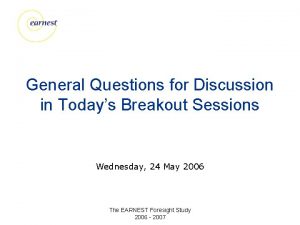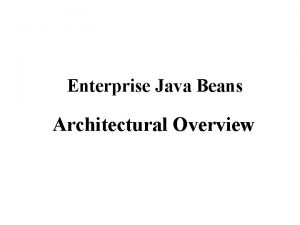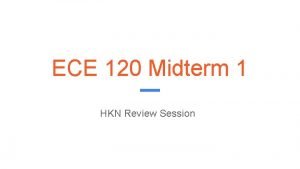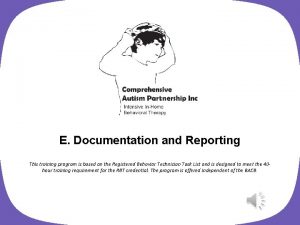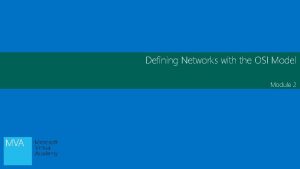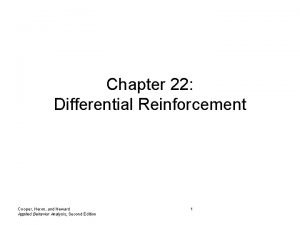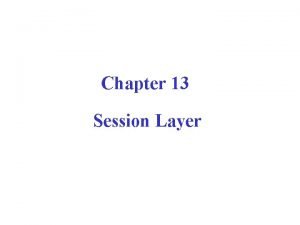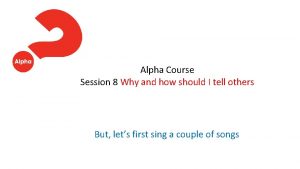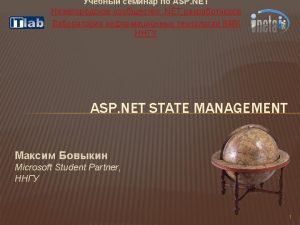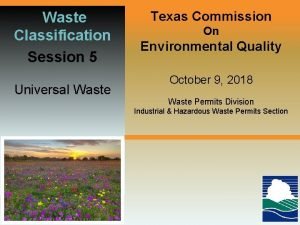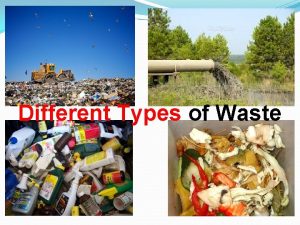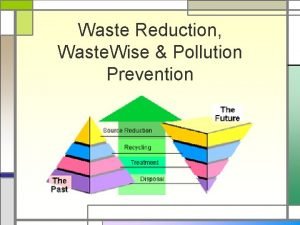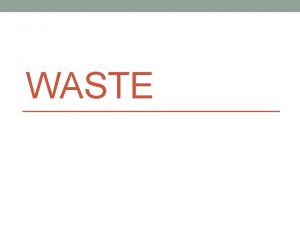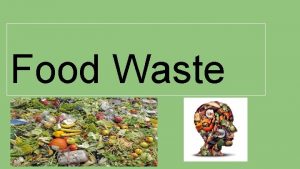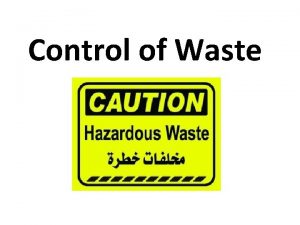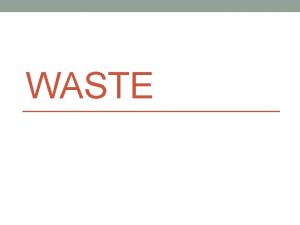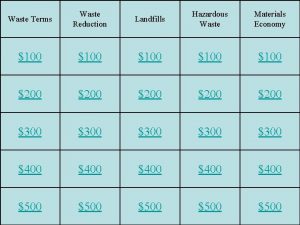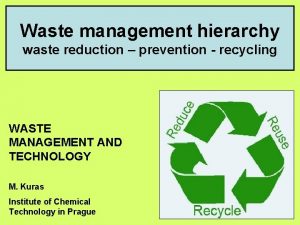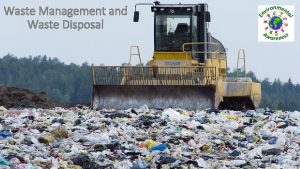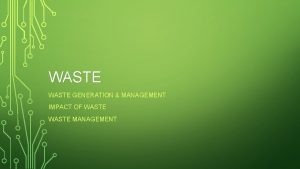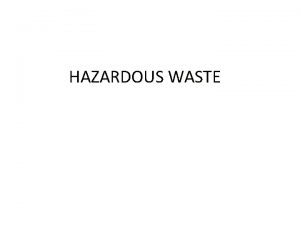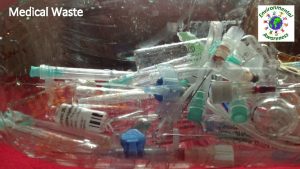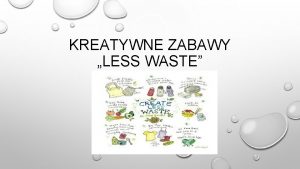Waste Classification Session 2 Waste Classification Presentation Part



















































- Slides: 51

Waste Classification Session 2 Waste Classification Presentation, Part 2, and Examples Texas Commission On Environmental Quality October 9, 2018 Waste Permits Division Industrial & Hazardous Waste Permits Section

Classification Examples

Example 1 Waste Description: An industrial generator has a spent solvent that is 15% by volume acetone. The remainder of the solvent is ethyl acetate and debris. The solvent is not ignitable at its point of generation and exhibits no other characteristics of a hazardous waste. Classification Questions: Is the waste an F-listed (F 003) waste, and if not, why not? What, if any, EPA code would it carry?

Example 1 Answers for Example 1: It is not ignitability at its point of generation. Therefore, it is not an F 003 listed waste. It contains no other hazardous waste constituents and exhibits no characteristic of a hazardous waste, So, it carries no hazardous waste code. However, it does exceed the 400 mg/l limit for acetone found in Table 1, Appendix 1 of 30 TAC Chapter 335 Subchapter R. Therefore, it is a Class 1 waste.

Example 2 Waste Description: A dry cleaner produces a spent solvent that is least 99%+ by volume tetrachloroethylene. Classification Questions: Is the waste an F-listed waste? If not, what EPA other EPA hazardous waste code would it carry?

Example 2 Answers for Example 2: The waste is a spent solvent containing at least 10% by volume tetrachloroethylene before use. Therefore it is a F 002 listed waste. It contains no other listed constituents, but it is characteristically hazardous for toxicity for tetrachloroethylene. Therefore, it also carries the code D 039 for toxicity.

Example 3 Waste Description: A pharmacy has expired and unused nicotine patches and nicotine gum that it needs to dispose. The SDS for the wastes say that nicotine is the only active ingredient in the patches and gum. Classification Questions: Is the waste a listed waste? If so, what EPA hazardous waste code would they carry?

Example 3 Answers for Example 3: Nicotine is the only active ingredient in the patches and gum. Nicotine is a P-listed waste and carries the P 075 hazardous waste code. There is no evidence of the patches or gum being a hazardous waste for any other reason, so they carry no other hazardous waste code.

Example 4 Waste Description: A manufacturing facility sandblasts metal parts and generates a blast media waste. A TCLP test shows the waste leaches: 2. 1 mg/l cadmium, 25. 3 mg/l chromium, 0. 1 mg/l arsenic, and 1. 8 mg/l lead Process knowledge shows that there are no listed or other constituents of concern present in the waste. Classification Questions: Is the waste a hazardous waste, and if so, what EPA hazardous waste code(s) would it carry?

Example 4 Answers for Example 4: There are no listed constituents present in the blast media, therefore it is not a listed HW. The threshold levels for the 4 TCLP metals are: 1 mg/l for Cadmium & 5 mg/l each for Arsenic, Chromium and Lead Hence, the media is characteristically hazardous waste for cadmium (2. 1 mg/l) and chromium (25. 3 mg/l). The carries the hazardous waste codes D 006 and D 007.

Example 5 Waste Description: A distillery has 2 waste streams. One is an off-spec mixture of 22% by volume alcohol and 78% other ingredients (e. g. water) that has a flash point of 59°C. The other is a petroleum distillate solvent with a flash point of 55°C. None of the distillates are listed hazardous wastes or on the TCLP list. Classification Questions: Are the wastes hazardous wastes? If so, what EPA hazardous waste code(s) do they carry?

Example 5 Answers for Example 5: The flash point of the off-spec water and alcohol mixture would ordinarily make it a D 001 characteristically hazardous waste. However, since its alcohol content is less than 23%, it is not a D 001 waste. * However, the solvents have no such exclusion. Hence, they are a D 001 hazardous waste. *Because the waste’s flash point is ˂65. 6°C, it is a Class 1 waste.

Example 6 Waste Description: A pharmaceutical laboratory generates a waste that contains two substances. One is on the U-list, and the other is on the P-list. Neither is characteristically hazardous and both are active ingredients in the waste when used in medical care. The waste also contains an antimony constituent with a TCLP level of 2. 0 mg/l Classification Questions: Is the waste a hazardous waste, and if so, what EPA hazardous waste code(s) would it carry? If not, what would be the waste’s classification?

Example 6 Answers for Example 6: You might be tempted to think that the waste is both a U and/or P listed waste. However, because both the potential listed constituents are active ingredients, the waste is neither a U nor a P listed waste. In fact, it is not a listed hazardous waste at all. However, because its antimony content exceeds the 1. 0 mg/l for antimony, and it is generated at an industrial facility, the waste is a Class 1 waste.

How to Create a Texas Waste Code Chapter 335, Subchapter R/RG-022

Texas Waste Code Formula Regulatory Compliance Most industrial and hazardous wastes are identified by an 8 -character Texas waste code. The purpose is to give the TCEQ information about the waste including its: • Origin; • General nature; and • Hazardous status

Texas Waste Code Formula 8 -Character Identification Number § Sequence Number § Form Code § Classification

Texas Waste Code Formula Sequence Number Sequence numbers may contain only numbers, alphanumeric or letters alone. 1. Generators that have an NOR used only 4 digit numbers between 0001 to 9999 that assigned by generator; 2. Alphanumeric sequence numbers are assigned by TCEQ for one-time shipments; and

Texas Waste Code Formula Sequence Number 3. Letters alone are used for: • “SPIL” for spills regulated under the Emergency Response Program; • “OUTS” for wastes generated outside of Texas; • “CESQ” for CESQG only wastes; • “TSDF” for facilities that consolidate wastes; • “UNIV” for universal wastes; and • “RRCT” for Railroad Commission of Texas wastes

Texas Waste Code Formula Form Code Second segment of a TCEQ waste code are the numbers found in Appendix 3 of 30 TAC Chapter 335, Subchapter R

Texas Waste Code Formula Classification The last character of a waste completes the Texas waste code. This will be either an H (for hazardous waste) or, a 1, 2 or 3 for nonhazardous industrial wastes.

Texas Waste Code Examples 00114882 (scrap wood on a NOR) SPIL 2091 (one-time spill of a nonhaz paint waste) OUTS 3011 (soil contaminated with oil from an out-ofstate clean-up project) CESQ 301 H (in state CESQG facility with a soil clean up waste) RRCT 2051 (Oil water mixture from a RRCT regulated site being disposed at a TCEQ facility)

Examples of How to Assign TCEQ Waste Code Numbers

Let’s Stop and Consider Containers

Texas Waste Code Formula What’s the Big Deal with Containers? Containers, more specifically the residues left in the containers, have historically been an environmental problem. For this reason, the TCEQ has established a rather elaborate regulatory framework for regulating containers.

Containers Classifying Containers (30 TAC § 335. 508(2)) Containers that have held a material that is or would be either a hazardous or Class 1 waste can be a Class 2 waste if the container is empty per 30 TAC § 335. 41(f)(2) and it: 1. Has a capacity of ≤ 5 gallons; or 2. If it has a capacity of ˃ 5 gallons: A. and the residue has been completely removed (e. g. , by triple rinsing, hydroblasting, etc. ); and B. the container is rendered useable (e. g. , by crushing); or C. after its residue has been completely removed, the container is recycled so that it is rendered unusable (e. g. by shredding, melting, etc. )

Example 7 Background Information A manufacturing facility generates 3 new container waste streams which are: (1) Empty containers per § 335. 41(f)(2) and ≤ 5 gal; (2) Empty containers per § 335. 41(f)(2) that are > 5 gal. ; and (3) > 5 gal metal containers that are empty per § 335. 41(f)(2) and that have been rendered unusable. By process knowledge, it’s known that all of the empty containers are metal and all previously contained the same liquid hazardous waste. How are these container wastes classified and coded?

Example 7 - Container Waste Here is what we know about the waste streams. 1. They are not exempt & are industrial wastes. 2. They all held a hazardous waste. 3. There are two sizes of containers (≤ 5 gal & ˃ 5 gal). 4. There are currently no waste codes on the facility’s NOR for the wastes. 5. Sequence numbers 0001 -0004 have already been assigned to other waste streams.

Example 7 - Container Waste Step 2 – Determine Waste Streams There are 3 waste streams here, or are there? If 2 or more wastes streams: (1) Are generated at the same physical address; (2) Have the same classification, including EPA hazardous waste codes, if any; (3) Share the same TCEQ Form Code; and (4) Are generated by essentially the same process; They can generally be combined under a single waste TCEQ waste code number.

Example 7 - Container Waste Step 2 – Determine Waste Streams In this example, the generator has the option of having either 2 or 3 separate waste codes for the new wastes. The generator has decided to combine the two Class 2 wastes under one waste code with a separate waste code for the Class 1 container waste.

Example 7 - Container Waste Step 3 – Assign Sequence Numbers 4 -digit sequence numbers are assigned to the wastes. Since sequence numbers 0001 -0004 have already been used, therefore, 0005 is assigned to the Class 1 container waste and 0006 to the Class 2 container waste. Form Code 308 (Empty or Crushed Metal Drums or Containers) is selected for both.

Example 7 - Container Waste Step 5 – 3 -digit Form Code (App G) Now putting it all together, we have : (1) Waste code 00053081 for the empty containers per § 335. 41(f)(2) that are of > 5 gal capacity; and (2) Waste code: 00063082 for the triple rinsed empty containers of ≤ 5 gal capacity and for the > 5 gal capacity containers that are empty per § 335. 41(f)(2) and that have been rendered unusable.

Example 2 – Industrial or Municipal?

Example 8 Step 1: Background Information A hospital generates a liquid waste that tested 2. 0 mg/l for lead, putting it below the hazardous waste regulatory limit of 5 mg/l for lead, but exceeding the regulatory limit of 1. 5 mg/l for a Class 1 waste industrial waste. How is this waste classified?

Example 8 Step 2: Background Information • The waste is a nonhazardous waste from a municipal source because hospitals are not industrial facilities. • Non-hazardous, municipal wastes do not need to be classified beyond determining that they are not a hazardous waste. • End result: This waste is not required to have a waste code.

Example 9 Abrasive Blast Media Waste

Example 9 Background Information A shipbuilding & maintenance company uses blasting media sand to remove paint from carbon and alloy steel during routine maintenance and repainting. Some of these paints contain heavy metals. By process knowledge, the blast media contains no TPH, PCBs or asbestos. The company already has 10 waste codes on its NOR (sequence numbers 0001 – 0010).

Example 9 Background Information Continued The waste stream is comprised of sand, carbonized steel and dried paint. A TCEQ accredited lab performs a TCLP analysis. All regulated metals test below hazardous and Class 1 regulatory levels.

Example 9 What do we know so far? • The waste comes from an industrial generator. • Analytical tests show that the waste is neither hazardous nor Class 1 for metals for organic constituents. • The waste contains no TPH, PCBs or asbestos. • Therefore, it’s Class 2 by default.

Example 9 Texas Waste Code Assignment • Form Code - for non hazardous sand blast waste from 30 TAC Chapter 335 Subchapter R, Appendix 3) is 389. • Process knowledge and analytical are used to make this determination. • Next logical sequence number is 0011. Waste code: 00113892

Example 10 - Wastewater Sludge

Example 10 Background Information: An industrial plant generates wastewater sludge from a production process that uses formaldehyde as an ingredient. SDS indicates that formaldehyde is a listed waste (U 122), and it is characteristically hazardous (D 001) for ignitability and reactivity (D 003). The waste is 85% water with the remainder being formaldehyde.

Example 10 Analytical tests show that the waste is neither ignitable, corrosive, reactive, nor TCLP hazardous. Analytical tests also show that the waste does not meet any of the criteria for being a Class 1 waste at point of generation. The facility has assigned the sequence number 0001 0005 to the other wastes on its NOR. How is the waste stream classified, and what is its TCEQ waste code?

Example 10 • U-listings only apply to unused chemical products per 40 CFR § 261. 33(a)-(f). • The “mixture/derived from” rule found in 40 CFR § 261. 3(c)&(d), which states that any waste stream derived from a listed waste carries the applicable listing(s) as well, does not apply. • Wastewater is not characteristically hazardous nor Class 1.

Example 10 Texas Waste Code Assignment Putting It All Together • Sequence number is 0006. • Form code for sludge with organic contaminants from (30 TAC 335 Subchapter R, Appendix 3) is 609. • Analytical test results and process knowledge supports a Class 2 designation. Sludge Waste Stream: 00066092

Example 11 Granite Fines Background Information A rock quarry produces a granite fines waste. Through process knowledge, the waste is “inert” as defined in 30 TAC § 335. 1(146)(A)(ii). Using the analytical test methods found in 30 TAC § 335. 507(4)(a) and process knowledge, the fines waste is shown to be essentially insoluble. The company has only one other waste code on its NOR which has been assigned sequence number 0001.

Example 11 Texas Waste Code Assignment The waste qualifies as a Class 3 waste. An acceptable for code for the waste is 119 (other inorganic solids). Using the next available sequence number, 0002, the waste code is: 00021193

Guidelines for the Classification and Coding of Industrial and Hazardous Waste, RG-022

RG-022 Helpful Hints 30 Texas Administrative Code (30 TAC) Chapter 335, Subchapter R is where the waste classification and coding regulations are found. RG-022, “Guidelines for the Classification and Coding of Industrial and Hazardous Waste”, is a useful document crafted to help generators of industrial and hazardous waste make sense of Subchapter R.

RG-022 Helpful Hints Some of the useful information in RG-022 is: • • A waste classification checklist (very helpful); The proper use of process knowledge The proper use of analytical testing Required documentation to support the classification of industrial and hazardous wastes • How to create a TCEQ waste code

How to Contact Us Texas Commission on Environmental Quality Industrial & Hazardous Waste Permits Section MC-130 * P. O. Box 13087 * Austin, TX 78711 -3087 Phone: 512 -239 -6412 (Queue) Fax: 512 -239 -6383 E-Mail: IHWPER@tceq. texas. gov
 Application presentation session transport network
Application presentation session transport network Number of bits borrowed
Number of bits borrowed Application presentation session transport network
Application presentation session transport network Scheduled waste management presentation
Scheduled waste management presentation Addition symbol
Addition symbol Part to part ratio definition
Part to part ratio definition Part part whole
Part part whole Technical object description example
Technical object description example Bar
Bar The part of a shadow surrounding the darkest part
The part of a shadow surrounding the darkest part Part to part variation
Part to part variation 8-5 project part two: presentation
8-5 project part two: presentation Fetal lie
Fetal lie Leopold maneuver
Leopold maneuver Sans 10234 waste classification
Sans 10234 waste classification Classification of waste according to their properties
Classification of waste according to their properties Classification of matter part a vocabulary review
Classification of matter part a vocabulary review Session 0 windows
Session 0 windows Welcome to new session 2020-21
Welcome to new session 2020-21 Session
Session Skill 23 anticipate the topics
Skill 23 anticipate the topics Team norming session
Team norming session 6 session name
6 session name Session name
Session name Asp.net session management
Asp.net session management Stateful session bean life cycle
Stateful session bean life cycle Multi product profit volume chart
Multi product profit volume chart Per session form
Per session form Ergonomics session
Ergonomics session Practical session meaning
Practical session meaning Multipicand
Multipicand Define session in php
Define session in php What is the value of the staff-session cookie?
What is the value of the staff-session cookie? Circle k #45067
Circle k #45067 Joint application development jad
Joint application development jad Poster imrad
Poster imrad Lac session template
Lac session template Hkn review session
Hkn review session Hkn review session
Hkn review session Breakout session questions
Breakout session questions Facilitate training session
Facilitate training session Javax.ejb.createexception jar
Javax.ejb.createexception jar Listening session template
Listening session template Ece 120
Ece 120 Sample aba session notes
Sample aba session notes Session protocol data unit
Session protocol data unit Full session drl aba
Full session drl aba Function of session layer
Function of session layer Meditech suspend session icon
Meditech suspend session icon Alpha session 8
Alpha session 8 Active session history
Active session history Asp net session state
Asp net session state
